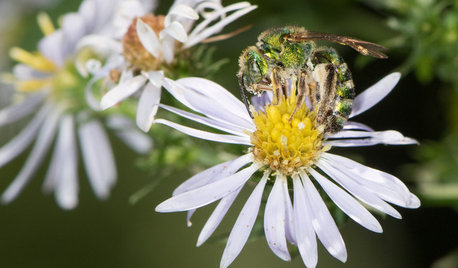Killer Bees
romur1
18 years ago
Related Stories

GARDENING FOR BUTTERFLIESGardening for the Bees, and Why It’s a Good Thing
When you discover how hard bees work for our food supply, you may never garden without them in mind again
Full Story
GARDENING GUIDESLook for Metallic Green Sweat Bees Visiting Your Garden This Fall
These beautiful sweat bees will dazzle and delight you with their bright emerald green color and midsummer and fall flower visiting
Full Story
GARDENING GUIDESWeed War: When and How to Use Chemical Herbicides
Before you spray, arm yourself with knowledge about which weed killers — natural or synthetic — are right for your yard
Full Story
HOUZZ TOURSHouzz Tour: Going for Broke in Las Vegas
With bold architectural moves and killer views, this 8,000-square-foot resort-style home doesn’t hold back
Full Story
LANDSCAPE DESIGN6 Great Ways With Garden Ground Covers
Use them as problem solvers, weed killers, color and texture providers ... ground cover plants have both practical and visual appeal
Full Story
FARM YOUR YARDHello, Honey: Beekeeping Anywhere for Fun, Food and Good Deeds
We need pollinators, and they increasingly need us too. Here, why and how to be a bee friend
Full Story
INSPIRING GARDENSWhat We Can Learn From Longwood Gardens’ New Meadow
Sustainability, ecology, native plant communities ... this public garden is brimming with lessons on horticulture for home gardeners
Full Story
LIFEHow Your Landscaping Can Keep Burglars Away
Prevent home break-ins with strategic landscaping and good practices instead of menacing — and maybe less effective — measures
Full Story
EARTH DAYThe Case for Losing the Traditional Lawn
Work less, help the environment and foster connections by just saying no to typical turf
Full Story
EDIBLE GARDENSA Formerly Weedy Lot Now Brims With Edibles and Honeybees
Photographers transform their barren backyard into an oasis filled with fruit, vegetables, honey, eggs and more
Full StorySponsored






txbeeguy
txbeeguy
Related Professionals
Norfolk Landscape Architects & Landscape Designers · Fort Lee Landscape Architects & Landscape Designers · Sand Springs Landscape Architects & Landscape Designers · Simi Valley Landscape Architects & Landscape Designers · Aurora Landscape Contractors · Gainesville Landscape Contractors · Jackson Landscape Contractors · Duarte Landscape Contractors · Holtsville Landscape Contractors · Lady Lake Landscape Contractors · Medford Landscape Contractors · Melrose Landscape Contractors · Peachtree City Landscape Contractors · Wentzville Landscape Contractors · North Aurora Landscape Contractorsromur1Original Author
txbeeguy
pennsylvania_pete
txbeeguy
ccrb1
romur1Original Author
txbeeguy
jwarner191
jwarner191
vancleaveterry